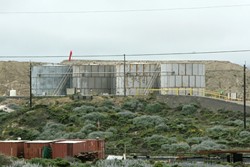Pending legal action by a group of Santa Marians, roughly 860,000 cubic yards of contaminated soil will soon depart the Unocal spill zone at the Guadalupe Dunes for a Santa Barbara County landfill.
Truckin’

- PHOTO BY JESSE ACOSTA
By declining the citizens’ request for a hearing, the commission removed the final roadblock in a scheme to remedy the former oilfield just north of the Santa Maria River, an eco-disaster site resulting from 38 years of unreported leaking by Unocal Corp. Oil giant Chevron purchased the California petrochemical company earlier this year and, thereby, shouldered the responsibility of an ongoing court-ordered cleanup effort.
The petitioners filing the appeal claimed state officials failed to provide proper notification to north Santa Barbara County residents before drafting plans to ship roughly 860,000 cubic yards of contaminated material down Highway 1. The Coastal Commission called the objection unfounded and whistled the final go-ahead.
Recently appointed commissioner Katcho Achadjian said the applicants failed to present new grounds to overturn the appeal. He also claimed Chevron and the hodgepodge of state and county bodies organizing the effort went far beyond ordinance requirements to inform all residents within 300 feet of the trucking route.
“This is a very appropriate solution,� said Achadjian, also a San Luis Obispo County Supervisor. “It’s environmentally friendly, the soil is of use to the landfill company, and the important thing is it’s leaving our territory.�
Speaking for the opposition, Daniel J. Kirk of Santa Maria said that, based on previous communication with Coastal Commission staff, the group largely expected the appeal’s denial. He stated they plan to take the order to court by filing a writ of mandate sometime in July.
“I appreciate that San Luis Obispo wants it out of the county, but it has to go somewhere,� Kirk summarized the group’s position. “The problem is 90 percent of the route runs through Santa Barbara County.�
The commission’s decision also validated a wealthy mitigation package offered two days earlier by Chevron to the City of Guadalupe. The roughly $1.4 million cluster of one-time and annual funding will allow the city to repair park space and provide additional firefighters.
On June 13, Guadalupe’s city council voted 4-0 to accept the package. Councilman Carlos Aguilera questioned the project’s potential effects on the Highway 1 corridor and pushed for Chevron to sweeten the deal. The rest of the council deferred, however, and unanimously accepted the proposal with Aguilera abstaining.
Guadalupe Mayor Lupe Alvarez expressed relief that the Santa Marians’ appeal did not derail his town’s public benefits.
“That possibility was in the back of my mind,� he said of the prospect of the Coastal Commission accepting the appeal. “I’m glad that they turned it down in the sense that we will receive these services in a timely fashion.�
According to Chevron officials, purging the largest oil spill site in United States history will require nearly 50,000 truckloads over the course of five years, starting in August. The final destination is the regional landfill east of Santa Maria, where the trucked soil will provide a capping layer, effectively closing the facility.
The fill includes soil from both the original oilfield and from digging ordered by state officials to protect the coastal water table from further contamination.
Once company planners and city staff complete the agreement, Chevron will hand over a $250,000 donation to improve city recreation space, plus funding for additional crosswalk guards, and an undisclosed sum to provide a permanent stoplight at the intersection of Highways 1 and 166.
The deal will also bankroll two full-time firefighter positions—$100,000 paid annually for five years—to supplement the city’s volunteer station. Alvarez reported that a shortage of volunteer firefighters during daytime hours often creates a bottleneck of medical calls.
Other stipulations of the agreement include a 20-mph speed limit on Highway 1 for the Chevron trucks, enforced by GPS blackbox. The City of Santa Maria, meanwhile, will receive approximately $6 million over the life of the project.
“Chevron is taking this very seriously,� Alvarez said. “They didn’t have to go through all this—they’ve done a great job reaching out to the city of Guadalupe.�
Comments